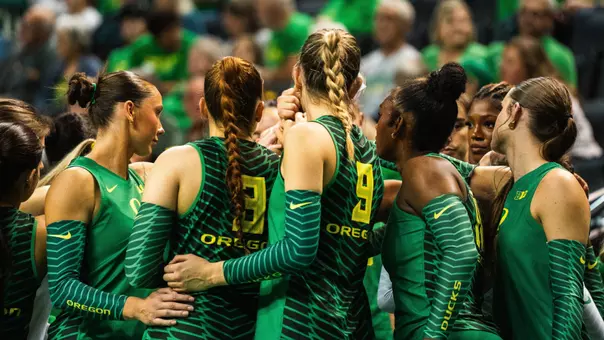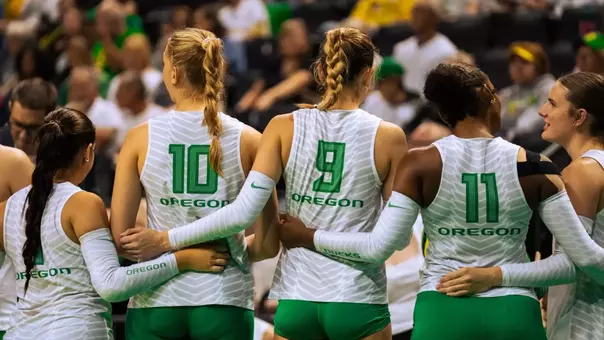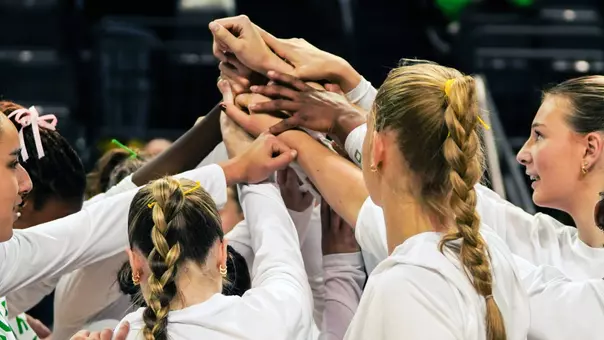
Photo by: Eric Evans/GoDucks.com
Advanced Data Proves Benson's Value as Ducks Visit No. 9 UCLA and USC
11/16/16 | Women's Volleyball, @GoDucksMoseley
First in the Pac-12 in Digs Per Set, Amanda Benson Leads Oregon Into Final Two Weeks of Regular Season
EUGENE, Ore. — Entering No. 19 Oregon' s match Friday at No. 9 UCLA, senior Amanda Benson leads the Pac-12 Conference in digs per set. For a volleyball player at the libero position, there isn't really a more illuminating measure of success, as conventional statistics go.
Hitters hit. Middle blockers block. Setters set. Libero's dig.
And Benson does do that as well as anyone. She averages 5.21 digs per set, not only most in the Pac-12 but 19th-most in the NCAA. Benson has 2,061 career digs, just 137 shy of the UO career record set by Katie Swoboda in 2008.
But Oregon coach Jim Moore considers Benson the best libero in the country for contributions that go beyond digging out opposing attacks. And he has reams of advanced data to support his position.
The skill Moore may value over any other is passing — Benson's ability not only to keep the ball from hitting the floor, but to pass it to the setter in a manner that facilitates the best possible attack for the Ducks. Volleyball coaches rate passes like critics rate restaurants; to a coach, a three-star pass is premier. Benson averages 2.71, three-tenths better than the Ducks as a team. Both the Ducks and their opponents manage a "quality pass" about 54 percent of the time; when it's Benson doing the passing, the rate spikes to 65 percent.
"We hit better when she passes," Moore said after a recent match, while looking at data on a large television screen in a meeting room in Matthew Knight Arena. "We side out better when she passes. We know that."
And Moore's analytics illuminate that Benson's defensive contributions go beyond volume of digs; it's her efficiency that's most impressive. In a match against then-No. 8 Washington earlier this year, Benson had a chance at 26 balls, and successfully kept 24 off the floor.
Oregon's dig percentage is about 68 percent, the best of any team Moore has ever coached, he said. Benson's individual rate is 76 percent. Against the Huskies earlier this year, she finished at an astounding 92 percent.
"I've never seen anything like that," Moore said. "None of us have."
Benson's skills in the back row have been honed over nearly a decade of focusing on that role. As a high school freshman in Arizona, she made the varsity team at libero. It wasn't one of the glamorous hitting positions, but Benson embraced it.
"I just took the libero role right from there and kept with it," she said last week, after helping Oregon to a win over Colorado on senior day at Matthew Knight Arena. "Never changed. I was hooked."
The most common statistic measuring libero play is digs, a defensive metric. But Benson has always been drawn to an offensive element: serve receive. She thinks of herself as offensive coordinator, positioning the Ducks in a way that baits opponents into serving to an advantageous spot on the floor, which then allows Oregon to set up its offense.
"I might put myself in one spot and then run to a different spot," Benson said. "I'm able to manipulate our serve receive and really mess with their server."
There are more numbers to back that up. Coaches track "first-ball side-out percentage" — the frequency with which they score on an opposing player's first serve, rather than allowing her to serve multiple balls in a row and give her team momentum.
UO opponents have a first-ball side-out percentage of 28.9. Oregon as a team is at 36.4. That jumps to 39.7 when Benson receives the serve. And in her last five games, with the Ducks shouldering the pressure of a heated race for first place in the Pac-12, Benson's number jumps again, to 42.1
Prior to a serve, Benson is looking for verbal and physical cues culled from film study that will betray where the serve is headed. She'll position herself so as to influence those decisions, then race to the spot where the ball arrives. While lunging to keep the ball off the floor, she'll also manipulate her body so as to pass off to setters Maggie Scott and August Raskie.
There are countless decisions and movements that must be carefully orchestrated in Benson's mind. But another hard-to-measure quality she possess is cool under fire.
"As chaotic as it may seem, it really isn't chaotic to me," she said. "In my head, it's very calm."
For nearly four years now, Moore has been able to rely on Benson's calming influence in every single set the Ducks have played. In the coming weeks, she'll use those skills to try and get the Ducks back into the NCAA Tournament, and hopefully beyond the first round, where they fell last season.
Given Oregon's youth, the next few weeks could be unpredictable. Benson will be an exception.
"There's never going to be a time," Moore said, "that Amanda's not going to contribute."
Interviews:
Jim Moore, Head Coach
Lindsey Vander Weide, Sophomore Outside Hitter
Hitters hit. Middle blockers block. Setters set. Libero's dig.
And Benson does do that as well as anyone. She averages 5.21 digs per set, not only most in the Pac-12 but 19th-most in the NCAA. Benson has 2,061 career digs, just 137 shy of the UO career record set by Katie Swoboda in 2008.
But Oregon coach Jim Moore considers Benson the best libero in the country for contributions that go beyond digging out opposing attacks. And he has reams of advanced data to support his position.
The skill Moore may value over any other is passing — Benson's ability not only to keep the ball from hitting the floor, but to pass it to the setter in a manner that facilitates the best possible attack for the Ducks. Volleyball coaches rate passes like critics rate restaurants; to a coach, a three-star pass is premier. Benson averages 2.71, three-tenths better than the Ducks as a team. Both the Ducks and their opponents manage a "quality pass" about 54 percent of the time; when it's Benson doing the passing, the rate spikes to 65 percent.
"We hit better when she passes," Moore said after a recent match, while looking at data on a large television screen in a meeting room in Matthew Knight Arena. "We side out better when she passes. We know that."
And Moore's analytics illuminate that Benson's defensive contributions go beyond volume of digs; it's her efficiency that's most impressive. In a match against then-No. 8 Washington earlier this year, Benson had a chance at 26 balls, and successfully kept 24 off the floor.
Oregon's dig percentage is about 68 percent, the best of any team Moore has ever coached, he said. Benson's individual rate is 76 percent. Against the Huskies earlier this year, she finished at an astounding 92 percent.
"I've never seen anything like that," Moore said. "None of us have."
Benson's skills in the back row have been honed over nearly a decade of focusing on that role. As a high school freshman in Arizona, she made the varsity team at libero. It wasn't one of the glamorous hitting positions, but Benson embraced it.
"I just took the libero role right from there and kept with it," she said last week, after helping Oregon to a win over Colorado on senior day at Matthew Knight Arena. "Never changed. I was hooked."
The most common statistic measuring libero play is digs, a defensive metric. But Benson has always been drawn to an offensive element: serve receive. She thinks of herself as offensive coordinator, positioning the Ducks in a way that baits opponents into serving to an advantageous spot on the floor, which then allows Oregon to set up its offense.
"I might put myself in one spot and then run to a different spot," Benson said. "I'm able to manipulate our serve receive and really mess with their server."
There are more numbers to back that up. Coaches track "first-ball side-out percentage" — the frequency with which they score on an opposing player's first serve, rather than allowing her to serve multiple balls in a row and give her team momentum.
UO opponents have a first-ball side-out percentage of 28.9. Oregon as a team is at 36.4. That jumps to 39.7 when Benson receives the serve. And in her last five games, with the Ducks shouldering the pressure of a heated race for first place in the Pac-12, Benson's number jumps again, to 42.1
Prior to a serve, Benson is looking for verbal and physical cues culled from film study that will betray where the serve is headed. She'll position herself so as to influence those decisions, then race to the spot where the ball arrives. While lunging to keep the ball off the floor, she'll also manipulate her body so as to pass off to setters Maggie Scott and August Raskie.
There are countless decisions and movements that must be carefully orchestrated in Benson's mind. But another hard-to-measure quality she possess is cool under fire.
"As chaotic as it may seem, it really isn't chaotic to me," she said. "In my head, it's very calm."
For nearly four years now, Moore has been able to rely on Benson's calming influence in every single set the Ducks have played. In the coming weeks, she'll use those skills to try and get the Ducks back into the NCAA Tournament, and hopefully beyond the first round, where they fell last season.
Given Oregon's youth, the next few weeks could be unpredictable. Benson will be an exception.
"There's never going to be a time," Moore said, "that Amanda's not going to contribute."
Interviews:
Jim Moore, Head Coach
Lindsey Vander Weide, Sophomore Outside Hitter
Players Mentioned
Trent Kersten & Sophia Meyers | Postgame vs. Wisconsin
Monday, October 27
Valentina Vaulet & Cora Taylor: "Working off of one another."
Friday, October 24
Trent Kersten: "I was super proud of them."
Friday, October 24
Trent Kersten | Postgame vs. Penn State
Sunday, October 19




















